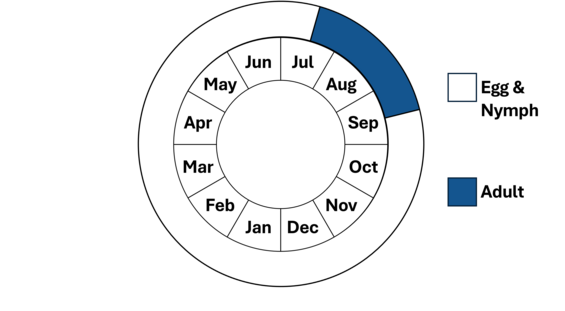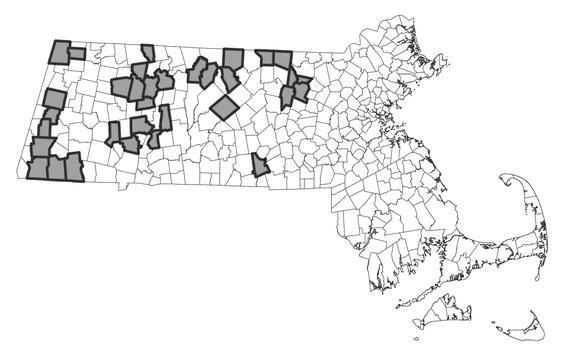- Scientific name: Stylurus scudderi
Species of Greatest Conservation Need (MA State Wildlife Action Plan)
Description
Male zebra clubtail
The zebra clubtail (Stylurus scudderi) is a large insect belonging to the order Odonata, sub-order Anisoptera (the dragonflies), and family Gomphidae (clubtails). The clubtails are a large, diverse group of dragonflies named for the lateral swelling at the tip of the abdomen that produces a club-like appearance which varies greatly among species. Clubtails are further distinguished from other dragonflies by their widely separated eyes, wing venation characteristics, and behavior. This species is in the genus Stylurus (hanging clubtails) a group characterized by having moderately flared clubs and relatively short legs. The zebra clubtail possesses a rather wide club, nearly as wide as the thorax (section behind the head), which includes the seventh, eighth, and ninth segments. The zebra clubtail is a very striking insect with black and yellow patterning, bright green eyes and black cross stripes on the face. The dark brown thorax has two short pale dorsal stripes, two lateral pale stripes, and fused dark stripes at the shoulder and more laterally. The black abdomen is marked with pale yellow rings. Abdominal segments eight and nine have a large yellowish spot located laterally on each side, while segment seven has a smaller spot in the same location. The three pairs of powerful legs are jet black and lined with spines. The sexes are similar in appearance, though the females have thicker abdomens, a less developed club, more extensive lateral pale markings on the abdomen, and a mark at the base of the hind leg femur.
Adult zebra clubtails range from 52-59 mm (2-2.3 in) in length. Fully developed nymphs may range from 26-36 mm (1-1.4 in) in the length.
Although many clubtails are similar in appearance, the zebra clubtail is a large and distinctively marked species. A combination of factors, including its ringed abdomen, green eyes, shape of terminal abdominal appendages and hamules in males, and the shape of vulvar lamina in females, help to easily distinguish this species from all other dragonflies in Massachusetts (Needham et al. 1999). The nymphs can be distinguished by characteristics of the abdominal segments and palpal lobes as shown in the keys in Walker (1958), Soltesz (1996) and Tennessen (2019).
Life cycle and behavior

Note, nymphs are present year-round.
Zebra clubtails are elusive, and little is known about their life history. The egg and nymph life stages are fully aquatic. The nymphs burrow into muddy and sandy substrate and are predators, feeding on a wide variety of aquatic insects, small fish, and tadpoles. Nymphs undergo several molts (instars) for at least 2 years until they are ready to emerge as winged adults. The nymph of the zebra clubtail generally emerges on the bank of the stream no more than ~1 m (3 ft) above the surface of the water. Although most dragonflies emerge during the early morning, or at night, the zebra clubtail has often been found emerging during the middle part of the day. As soon as the freshly emerged (teneral) adults are dry and the wings have hardened sufficiently, they fly off to seek refuge in the vegetation of adjacent uplands, leaving their larval exoskeletons behind. These cast exoskeletons, known as exuviae, are identifiable to species and provide a reliable, useful means of determining species presence and viable nymph habitat.
Immature adults spend several days or more feeding and maturing, before returning to their breeding habitats. When not feeding, zebra clubtails perch horizontally on rocks, logs, vegetation or the ground. Zebra clubtails breed in late summer, mostly from mid-July through August, though sometimes continuing into September. Male zebra clubtails patrol the stream, flying low and quickly over the surface of the water, often at riffles, in search of females and defending territories. They frequently land on the bank, logs, rocks and occasionally shoreline vegetation. When a female is found, the males grabs her and secures her with his terminal abdominal appendages which fit into special grooves in back of her eyes. The female swings the tip of her abdomen, where her reproductive organs are located, towards the male’s hamules, located on the underside of the second abdominal segment, forming the “wheel position” with the male on top and the female below. When a male zebra clubtail secures a female, the pair leaves the stream and flies up into forest, usually to the tops of the trees, to mate. Oviposition occurs after mating has been completed. Female zebra clubtails oviposit alone by rapidly flying over the surface of the water, often over riffles, and dipping the tip of her abdomen into the water every few feet until flying back into the riparian canopy.
The zebra clubtail is a late flying species. Emergence in Massachusetts probably occurs in early July. Following maturation, which may take a week, zebra clubtails can be seen at breeding habitat from mid-July through early September.
Distribution and abundance
The zebra clubtail range extends from Nova Scotia west to Ontario and south to Georgia, Tennessee and Michigan. The zebra clubtail has been found in every New England state, though it appears to be absent from the southeast coastal plain. In Massachusetts, the species occurs in the Hoosic, Housatonic, Farmington, Westfield, Deerfield, Middle Connecticut, Millers, Chicopee, Nashua, and Quinebaug watersheds.
The zebra clubtail was previously listed as species of Special Concern (delisted in 2012). Through nymph and exuviae surveys, several robust populations occur throughout Massachusetts with some occurrences recorded in degraded water quality and altered physical habitat suggesting a level of tolerance and/or residency to habitat alteration.

Distribution in Massachusetts.
1999-2024
Based on records in iNaturalist, Odonata Central, and Natural Heritage databases.
Habitat
Zebra clubtails inhabit medium-sized forested streams. Substrates are typically sand, gravel, and cobble with slow to moderate flow and intermittent riffles and rapids, which usually have some intermittent rapids. Nymphs inhabit depositional habitats and adults also inhabit riparian and upland forests and clearings.
Healthy habitats are vital for supporting native wildlife and plants. Explore habitats and learn about conservation and restoration in Massachusetts.
Medium-sized, sandy stream suitable for zebra clubtail.
Threats
Degradation of water quality, alteration of streamflows, and upland habitat loss are primary threats to zebra clubtail. Potential threats to water quality include pollution and sewage overflow, salt and other road contaminant run-off, and siltation from construction or erosion. The disruption of natural flow regimes by flow regulation projects, damming, and stream channelization may have a negative impact on populations. Climate change is projected to severely reduce suitable habitat and may be the most vulnerable to climate change (Collins and McIntyre 2017). Additional threats illegal or accidental industrial discharge and hardening of channel banks and siltation that creates unstable stream habitat.
Conservation
Survey and monitoring
Standardized and targeted surveys for zebra clubtail are needed to update its status in Massachusetts. Surveys should target historical and new stream sites to determine species occupancy and population status. Surveys for exuvia and adults are likely to be more effective for detection compared to either alone. Exuviae surveys should target the species emergence period in late July to maximize detection. Adult surveys should target stream and streambank habitats during their flight period during standardized weather and time windows to maximize species detection. Multiple site visits (e.g., ≥3) may be required to detect this species. Routine monitoring of prioritized sites is needed estimate occupancy trends overtime.
Management
Upland and stream habitat protection is critical for the conservation of zebra clubtail. Protection of forested upland borders of these river systems are critical in maintaining suitable water quality and are critical for feeding, resting, and maturation. Development of these areas should be discouraged, and the preservation of remaining undeveloped uplands should be a priority. Alternatives to commonly applied road salts should tested to minimize freshwater salinization. Hardened and channelized stream segments should be restored to promote natural sediment dynamics.
Research needs
Research effort is needed to estimate detection and occupancy rates and how other environmental variables (e.g., sample timing, weather) affect these rates. Other research efforts include projections of species distribution under climate change scenarios and climate vulnerability analysis in Massachusetts.
References
Collins S.D., and N.E. McIntyre. “Extreme loss of diversity of riverine dragonflies in the northeastern U.S. is predicted in the face of climate change.” Bulletin of American Odonatology 12,1 (2017):7-19.
Dunkle, Sidney W. Dragonflies Through Binoculars. Oxford University Press, 2000.
Lam, E. Dragonflies of North America. Princeton NJ: Princeton University Press, 2024.
Needham, J.G., M.J. Westfall, Jr., and M.L. May. Dragonflies of North America. Scientific Publishers, 2000.
Nikula, B., J.L. Ryan, and M.R. Burne. A Field Guide to the Dragonflies and Damselflies of Massachusetts. 2nd ed. Massachusetts Natural Heritage and Endangered Species Program, 2007.
Paulson, D. Dragonflies and Damselflies of the East. Princeton NJ: Princeton University Press, 2011.
Soltesz, K. Identification Keys to Northeastern Anisoptera Larvae. Center for Conservation and Biodiversity, University of Connecticut, 1996.
Tennessen, K. Dragonfly Nymphs of North America: An identification guide. Springer, 2019.
Contact
| Date published: | April 10, 2025 |
|---|